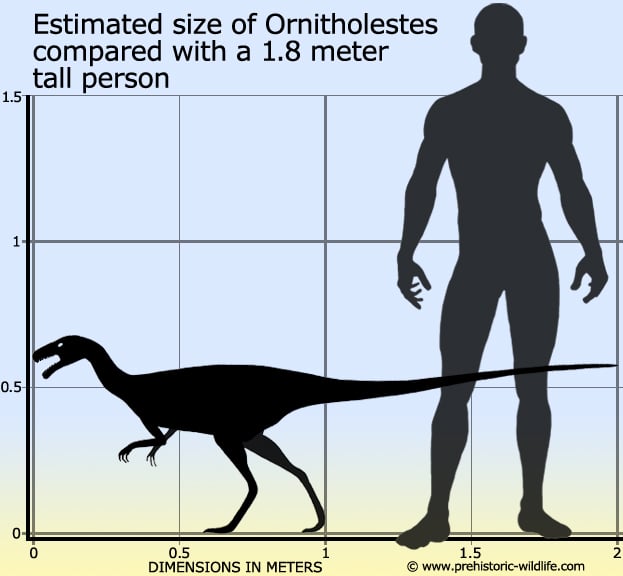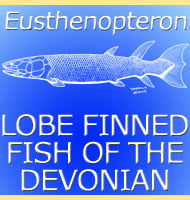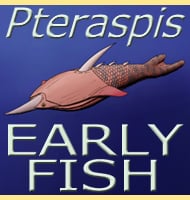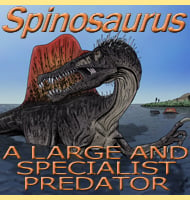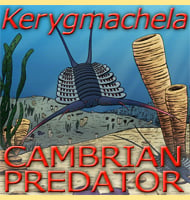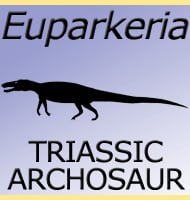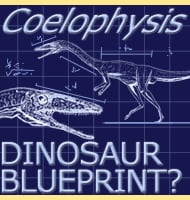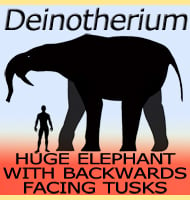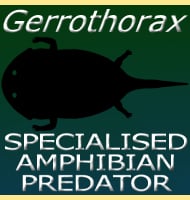In Depth
An interesting fact about Ornitholestes is that since it was first discovered in July of 1900, it was the first theropod dinosaur to be discovered in the twentieth century. Since this time, Ornitholestes has been regularly depicted in books, art and even dinosaur documentaries such as the BBC series Walking With Dinosaurs. However, today many of these reconstructions are actually considered to be inaccurate due to original misinterpretation of the fossils as well as assumed ideas about this dinosaur’s behaviour.Physical appearance
In general appearance Ornitholestes was a small theropod dinosaur that was built for speed and agility rather than strength and brute force. However the lower leg bones (missing in the type specimen) are thought to have been slightly shorter than the femur, something that is contrary to other fast running dinosaurs. This might indicate that while Ornitholestes was a lightweight reasonably fast theropod, it was not suited to chasing other small bipedal dinosaurs. Up to half of the total body length was made up of the tail which would have served as a balancing aid.
In terms of scale the skull of Ornitholestes was not as large in proportion to the body as the skulls of other known theropods. Despite this the skull and lower jaw were robust in their overall construction. The teeth at the front of the mouth were conical with slight serrations, which would have made them useful for tearing pieces of flesh from a carcass. The teeth at the back however were recurved (pointed to the back of the mouth) with enhanced serrations which would have allowed them to more effectively slice through meat.
Ornitholestes may not have relied upon its teeth and mouth for prey capture however for two reasons. One is that the relatively small size of the skull and hence mouth meant that catching prey would be more difficult with the mouth. Two is the fact that the arms of Ornitholestes were comparatively long, two thirds the total length of the legs. These arms also had hands with long fingers and had joints which allowed them to move in much wider arcs than larger and more primitive theropods which relied upon their mouths for prey capture. As such since the arms were the best adapted body part for capturing prey, it’s logical to reason that Ornitholestes used them to catch and hold onto prey while the mouth was possibly used to deliver a killing bite before feeding.
The feature that Ornitholestes is most commonly depicted with is a small crest on the tip of its snout. This crest was once thought to have been a display feature and perhaps a sign of sexual dimorphism between males and female, however this crest is now thought to have not even existed at all. Because it had been subjected to intense subterranean pressures when it went through the fossilisation process, the skull was badly crushed. Subsequent reviews of Ornitholestes (Rauhut, 2003 and Carpenter et al. 2005) have now concluded that this crest was actually a piece of the skull that had been split from the main bone and pushed upwards, giving the false impression that a crest was present in the living dinosaur. Subsequently, more modern depictions of Ornitholestes now show it without the nasal crest.
There is long running debate as to whether Ornitholestes did or did not have feathers, or at least primitive versions of them. Initially proposed by Percy Lowe in 1944, the idea was largely dismissed as fancy by other palaeontologists, but much later discoveries of fossils from China of the similarly sized Sinocalliopteryx and Sinosauropteryx show that at least some small dinosaurs had a downy covering of hair-like feathers. Further study and research into wider dinosaur groups has yielded that many more of the small theropods than previously thought may have had downy feather covering; we just didn’t know to look before because those parts had not been preserved in other fossils. It remains to be seen if Ornitholestes had a covering of primitive feathers, but most palaeontologists today are not so quick to ignore the idea as there predecessors were. If true then these primitive feathers would have provided Ornitholestes with insulation that may also suggested a reasonably fast metabolism and by extension a dinosaur with an active lifestyle.Behaviour and ecological niche
Many people will now about the famous depiction of an Ornitholestes catching an Archaeopteryx that was created by the great paleo artist Charles R. Knight. This image was based upon the literal translation of the name Ornitholestes which means ‘bird robber’ and helped fix the idea that Ornitholestes was a hunter of primitive birds into the public imagination. The problem with this picture is that Ornitholestes is so far only known from the western United States, while Archaeopteryx is only known from central Europe. While these two continents were closer together during the Jurassic, current fossil evidence simply does not support this exact idea of predator/prey interaction. Despite this however the concept could yet prove to be quite accurate.
When looking at the body of Ornitholestes you have three clues to its predatory behaviour. One is the lightweight body and quite long legs which meant that Ornitholestes would have been fast, but probably not as fast as other similarly sized dinosaurs that had longer legs. Two is the small skull size, not really suitable for attacking equally sized or larger dinosaurs. Third are the grasping arms that could easily arc to clasp around objects. When you put all of these things together you end up with a predator that is supremely adapted to chasing and catching smaller vertebrate animals like lizards and possibly even primitive mammals that were no bigger than most of today’s small rodents. Proto-birds would have also been potential prey had they also been active in the same habitats as Ornitholestes. Small prey animals like these would also not have required much power to kill, and the small yet robust skull and jaw may have been connected by reasonably strong biting muscles capable of closing the jaws in a killing bite. The slicing teeth at the back of the mouth would have also made short work of the bodies of small prey.
It is also not completely out of the question that Ornitholestes was a predator of other dinosaurs, particularly juveniles that were not fully developed enough to escape. Additionally as a carnivore Ornitholestes probably would also scavenged carrion whenever the opportunity presented itself as scavenging requires less energy expenditure that actively hunting prey. On the predatory food chain of the Jurassic North America however Ornitholestes would still have been reasonably low down. Larger theropods such as Ceratosaurus and Allosaurus, both of them known from the same formation as Ornitholestes, grew much bigger and even juveniles of these genera would have been capable of killing and eating a careless Ornitholestes.Classification - the relationship of Ornitholestes to other dinosaurs
Ornitholestes was named in 1903 by Henry Fairfield Osborne, the man who named many of some of the most famous dinosaur genera including Tyrannosaurus in 1905 and Velociraptor and Oviraptor, both in 1924. As a small theropod Ornitholestes ended up being placed within the Coelurosauria, the group of theropods that at the time became home for most small theropod dinosaurs. In 1920 Ornitholestes effectively ceased to exist when Charles Whitney Gilmore declared it to be the same dinosaur as Coelurus, another small theropod that is known from the Morrison Formation, but only by partial remains. This theory was reinforced in 1934 when Oliver Perry Hay created the species Coelurus hermanni based from the original description of Ornitholestes hermanni.
Almost half of the century passed until Ornitholestes was resurrected as a genus by John Oestrum in 1980. The classification of theropods had moved on a long way since the 1930s, but the exact position of Ornitholestes still and continues to spark debate amongst palaeontologists. In 1988 Gregory S. Paul proposed that Ornitholestes was similar to Proceratosaurus on the grounds that they had a similar skull structure. Indeed Proceratosaurus does have a small nasal crest on the tip of its snout, a feature that at the time was also thought to be present in Ornitholestes. Paul also detailed that these two genera were possibly related to Allosaurus, the top predator during the late Jurassic.
Although a good theory at the time, is was eventually realised by researchers, including Paul, that there is no direct familial link amongst these three dinosaurs. In fact later study upon Proceratosaurus has now seen it treated as possibly the earliest known tyrannosauroid. Ornitholestes is now back within the Coelurosauria which today is the group of theropods that are thought to be closer to birds than more primitive theropods like carnosaurs such as Allosaurus. Some palaeontologists have gone even further by placing Ornitholestes within the Maniraptora (‘hand snatchers’) which also includes dromaeosaurs and troodonts as well as oviraptorids and therizinosaurs amongst others. Not all palaoentologists are in agreement as to how Ornitholestes fits into this sub group, but Ornitholestes is often considered to be a more primitive member.
Partial hand remains that were once attributed to Ornitholestes are now widely thought to belong to another dinosaur called Tanycolagreus, yet another small theropod from the Morrison Formation that was found a few hundred meters away from the hand.
Further Reading
– Ornitholestes hermanni, a new compsognathoid dinosaur from the Upper Jurassic. – Bulletin of the American Museum of Natural History 19(12):459-464. – H. F. Osborn – 1903. – Skeletal adaptations of Ornitholestes, Struthiomimus, Tyrannosaurus. – Bulletin of the American Museum of Natural History. 35 (43): 733–771 – H. F. Osborn – 1917. – Coelurus and Ornitholestes: Are they the same? – John H. Ostrom. – In, Aspects of Vertebrate History: Essays in Honor of Edwin Harris Colbert. Museum of Northern Arizona Press. – Louis L. Jacobs (ed.) – 1980. – Redescription of the Small Maniraptoran Theropods Ornitholestes and Coelurus, by Kenneth Carpenter, Clifford Miles, John H. Ostrom & Karen Cloward. – In, The Carnivorous Dinosaurs. Life of the Past. Indiana University Press. pp. 49–71. – Kenneth Carpenter (ed.) – 2005a. – New Small Theropod from the Upper Jurassic Morrison Formation of Wyoming, by Kenneth Carpenter, Clifford Miles & Karen Cloward. – In, The Carnivorous Dinosaurs. Life of the Past. Indiana University Press. pp. 49–71. – Kenneth Carpenter (ed.) – 2005b.
